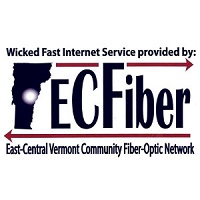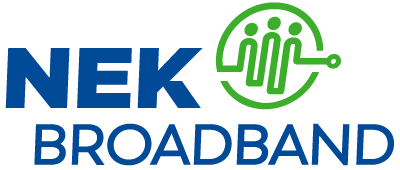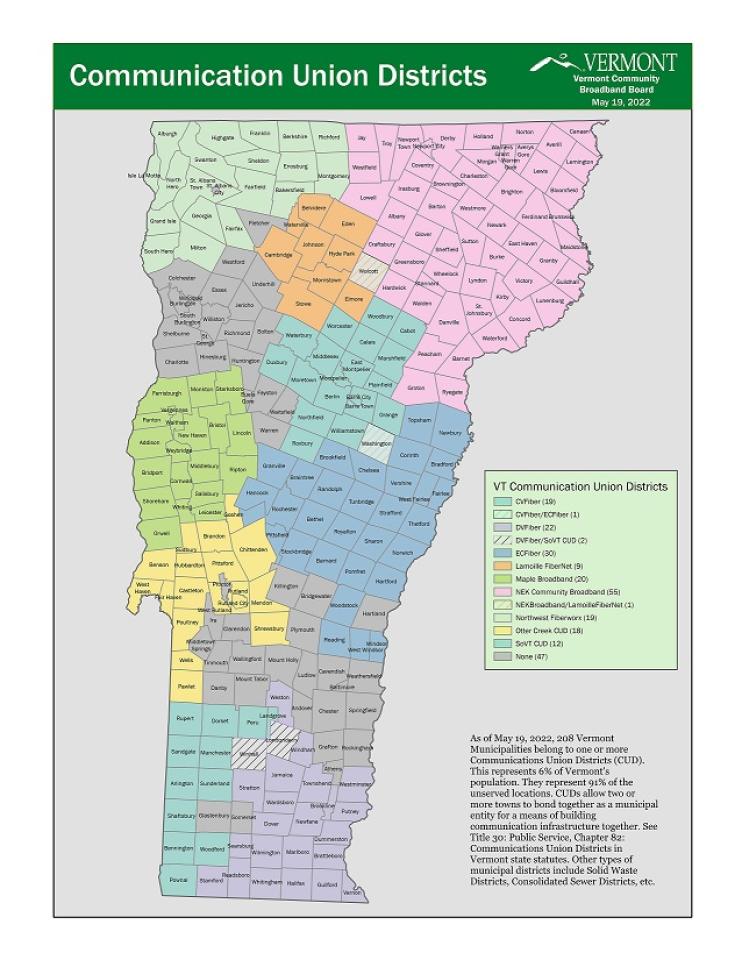
Fast, affordable Internet access for all.

It was a big week for ECFiber as Vermont’s first – and oldest – Communication Union District (CUD) celebrated lighting up the last hub of its 1,500 mile-network in White River Junction.
To mark the occasion of connecting the “golden patch cord” that will extend high-speed Internet service to eight more communities in the Upper Valley region, White River Junction’s VFW Hall was packed this past Tuesday with CUD officials, local and state leaders, enthusiastic residents, and U.S. Sen. Peter Welch. They were there to celebrate what ECFiber officials liken to “the Golden Spike moment tying the first transcontinental railroad together.”

After a 30-piece band played marching tunes, ECFiber Chairman F.X. Flinn marched to the podium to describe the meaning of the moment.
"It’s come to fruition today with a lighting of the White River Junction hub," he said. "This is the last piece of the puzzle for the network we originally envisioned that would bring world-class broadband to every home and business in the 23 member towns that originally voted town meeting day 2008 to create ECFiber."
Sen. Welch, an ECFiber subscriber who also spoke at the event, credited the state’s community broadband approach as the linchpin to solving the state’s digital divide:
“If we in rural Vermont were going to depend on the big telecommunication companies to wire our homes and get us Internet, we’d be waiting until our grandchildren had grandchildren. It wasn’t going to happen.”
Eight More Towns Join CUD
The United States Department of Agriculture (USDA) has awarded a $17.5 million grant to NEK Community Broadband (NEK Broadband), providing another shot in the arm for Vermont’s fast-growing collection of Communications Union Districts (CUDs). Such CUDs continue to play a starring role in Vermont’s efforts to finally conquer the digital divide.
NEK Broadband’s latest grant comes from the USDA’s ReConnect Loan & Grant Program, which helps defray the costs of network hardware and broadband deployment to rural and traditionally underserved U.S. markets.
The program this week doled out an additional $714 million in grants and loans to projects across 19 states.
NEK Broadband officials say its $17.5 million award will be combined with a $5.8 million investment to deliver affordable fiber access to 3,295 homes, 94 businesses, 183 farms and 11 educational facilities across 22 towns in Orleans, Caledonia, and Essex counties in Vermont.

“For too long, large pockets of our state have been denied this critical resource because companies haven’t found it profitable enough to invest,” Vermont Senator Bernie Sanders said in an announcement of NEK’s latest grant. “This federal funding is transformative, because the money is going directly to the very communities who will benefit, instead of having to go through those who care more about profits than delivering service.”
Two months after President Biden’s belated and long-stalled Federal Communications Commission (FCC) nominee withdrew her nomination after a year-long attack campaign against her, today at the Broadband Communities Summit in Houston, Texas, Gigi Sohn announced her next move: Sohn will serve as the first Executive Director for the American Association of Public Broadband (AAPB).
A non-profit organization formed by a group of municipal officials, AAPB’s mission is to advance advocacy efforts on behalf of publicly-owned, locally-controlled broadband networks. Since the organization first announced its formation at the Broadband Communities Summit in May of 2022, it has been working to educate federal and state policymakers who “have turned to the telecom lobby for help and are receiving biased guidance” on the community broadband networks approach, just as $42.5 billion from the Infrastructure Investment and Jobs Act (IIJA) is set to flow to state governments to expand high-speed Internet access this summer.
During a keynote luncheon at the summit, Sohn was joined by AAPB founding board members Bob Knight and Kimberly McKinley on the main stage for a candid discussion in which she reflected on the state of Internet access in the U.S. and her experience that led to her to withdraw her nomination to the FCC. Near the end of the luncheon she announced her new role with AAPB, which was greeted by a standing ovation from the hundreds of attendees in the audience.
Freedom to Choose Community Broadband Future
The announcement was followed by a press briefing where she elaborated on her vision for AAPB.
“I will be the first Executive Director of the American Association of Public Broadband. Until now, there has not been a membership-based advocacy organization that works to ensure that public broadband can grow unimpeded by anti-competitive barriers. That’s despite the success of public broadband to help places like Chattanooga and the Massachusetts Berkshires transform from sleepy hamlets to vibrant centers of economic opportunity, education and culture,” she said at the press briefing.

It's December, which means it's time to pull the staff together and get a handle on what happened in the broadband landscape in 2022. Joining Christopher is GIS and Data Visualization Specialist Christine Parker, Associate Researcher Emma Gautier, Outreach Team Lead DeAnne Cuellar, Senior Reporter and Communications Team Lead Sean Gonsalves, and Senior Researcher and Research Team Lead Ry Marcattilio.
Fitting all of those titles into one recording studio was a real project, but it led to a constructive conversation about preemption laws, the broadband nutrition label, BEAD funding and the new Broadband Data Collection (BDC) process, the supply chain, and more. There were a couple of surprises in 2022, and the staff reckons with how their predictions from last year held up in the face of things.
This show is 53 minutes long and can be played on this page or via Apple Podcasts or the tool of your choice using this feed.
Transcript below.
We want your feedback and suggestions for the show-please e-mail us or leave a comment below.
Listen to other episodes here or view all episodes in our index. See other podcasts from the Institute for Local Self-Reliance here.
Thanks to Arne Huseby for the music. The song is Warm Duck Shuffle and is licensed under a Creative Commons Attribution (3.0) license.
NEK Broadband has been awarded a $16 million grant by the Vermont Community Broadband Board (VCBB) to expand fiber access to 10 new Vermont communities. It’s among the earliest of what is likely to be a flurry of activity by the mostly-newly created Communications Union Districts - partnerships between rural cities and towns - which have formed over the last few years to solve the connectivity crisis for the tens of thousands of Vermonters who have been left behind by the current broadband marketplace.
A New Approach
Vermont’s broadband policy leaders say they plan to embrace CUDs as the primary avenue by which they hope to bridge the state’s long standing digital divide. A significant portion of the state’s $150 million broadband package will be funneled toward CUDs in a state where 85 percent of municipalities and 90 percent of underserved locations fall within a CUD.

The formation of most of the state’s CUDs is relatively new, though the most veteran example (EC Fiber) formed more than fifteen years ago. After years of persistence by EC Fiber, determined progress, and attitudinal changes in policy at the state level, CUDs now sit at the heart of the state’s rural broadband efforts.
With nearly 65,000 households unable to connect to the Internet at basic broadband speeds of 25/3 Megabits per second (Mbps), municipalities across the Green Mountain State have risen to the fore in formulating creative models for addressing the tens of thousands of homes without broadband access. Iterating on the EC Fiber (with roots back to the early 2000s), joint, municipally led projects have led to the creation of a total of nine Communications Union Districts (CUDs) at present, which places community-owned broadband at the forefront in Vermont.
What’s equally exciting is that the state has likewise stepped up, calling the CUDs the primary avenue by which it will solve the state’s connectivity crisis, and funneling at least $116 million in their direction in the next handful of years, with much of this spending dedicated to CUDs. To date, nearly 85 percent of Vermont’s municipalities and 90 percent of its underserved locations fall within a CUD.

This week on the podcast, Christopher is joined by Will Anderson, Program Coordinator at Vermont Communications Union Districts Association (VCUDA) and Evan Carlson, Board Chair at NEK Broadband (Northeast Kingdom, VT). During the conversation, the three discuss the origins and progress of Vermont’s Communications Union District (CUD) model, how the Department of Public Service has worked to support CUDs with better broadband mapping and data, and NEK Broadband’s journey from identifying a need to connecting their first customers. Christopher, Will and Evan also talk about how CUDs establish partnerships with local ISPs to keep broadband money circulating in the local economy and how CUDs are primed to take advantage of federal COVID relief money.
This show is 35 minutes long and can be played on this page or via Apple Podcasts or the tool of your choice using this feed.
Transcript below.
We want your feedback and suggestions for the show-please e-mail us or leave a comment below.
Listen to other episodes here or view all episodes in our index. See other podcasts from the Institute for Local Self-Reliance here.
Thanks to Arne Huseby for the music. The song is Warm Duck Shuffle and is licensed under a Creative Commons Attribution (3.0) license.
This week on the podcast, Christopher is joined by Will Anderson, Program Coordinator at Vermont Communications Union Districts Association (VCUDA) and Evan Carlson, Board Chair at NEK Broadband (Northeast Kingdom, VT).
During the conversation, the three discuss the origins and progress of Vermont’s Communications Union District (CUD) model, how the Department of Public Service has worked to support CUDs with better broadband mapping and data, and NEK Broadband’s journey from identifying a need to connecting their first customers. Christopher, Will and Evan also talk about how CUDs establish partnerships with local ISPs to keep broadband money circulating in the local economy and how CUDs are primed to take advantage of federal COVID relief money.
This show is 35 minutes long and can be played on this page or via iTunes or the tool of your choice using this feed. You can listen to the interview on this page or visit the Community Broadband Bits page.
Transcript coming soon.
We want your feedback and suggestions for the show-please e-mail us or leave a comment below.
Listen to other episodes here or view all episodes in our index.
Subscribe to the Building Local Power podcast, also from the Institute for Local Self-Reliance, on iTunes or Stitcher to catch more great conversations about local communities, the concentration of corporate power, and how everyday people are taking control.

In this episode of the podcast, we're back for another staff conversation about all that 2021 had to offer and serve up some predictions for the coming year. Joining Christopher on the show are Senior Reporter and Editor Sean Gonsalves, Community Broadband Outreach Team Lead DeAnne Cuellar, Senior Researcher Ry Marcattilio-McCracken, GIS and Data Visualization Specialist Christine Parker, and Associate Broadband Researcher Emma Gautier.
Christopher, Ry, and Sean reckon with their predictions from a year ago, with DeAnne, Christine, and Emma joining the podcast for the first time. During the conversation, we talk about the number of preemption laws we hope to see disappear in 2022, the strides taken in small and medium-sized cities to take control of their telecommunications infrastructure future, mapping, and the impact the unprecedented amount of federal money is likely to have across the country in the coming year.
This show is 50 minutes long and can be played on this page or via Apple Podcasts or the tool of your choice using this feed.
Transcript below.
We want your feedback and suggestions for the show-please e-mail us or leave a comment below.
Listen to other episodes here or view all episodes in our index. See other podcasts from the Institute for Local Self-Reliance here.
Thanks to Arne Huseby for the music. The song is Warm Duck Shuffle and is licensed under a Creative Commons Attribution (3.0) license.
ILSR’s Community Broadband Initiative Director Christopher Mitchell recently joined Kimberly Adams on Marketplace Tech to talk about the $65 billion in the infrastructure bill that is being allocated to expanding broadband access. The pandemic exposed many inequities in our economy including the lack of robust Internet connectivity in many rural areas. The infrastructure bill is a start to mending the injustices that have existed in the broadband sector for over a decade.
The key takeaway from the infrastructure bill, Christopher explains, is “that we are going to see unprecedented investment in rural connectivity, and we have multiple years’ worth of subsidies for low-income families, where they don’t earn enough money to be able to afford the connection that may already be available to them.”
Vermont, one of the most rural states on the map, is a successful model for developing reliable broadband systems. “They have developed a system in which a lot of the nearby communities can band together. They work with a local provider, and that company will then use the infrastructure that is owned by the community to deliver services across it.”
Building equitable broadband infrastructure is no small feat. Critical components easily get lost in legislation, like affordable connectivity for middle-class Americans. As Christopher puts it, “What about the rest of us?” This is one success, of many, in the long fight for accessible Internet connectivity.
Listen to the episode below, or here.
This story originally appeared on ILSR.org. Read the original here.